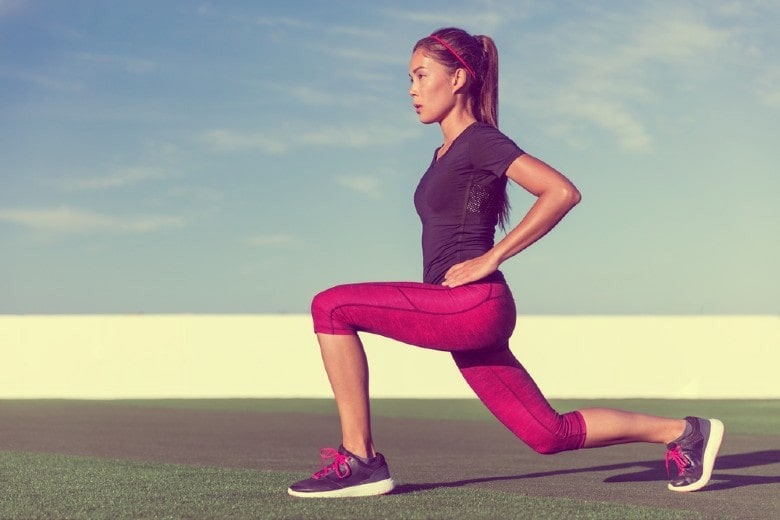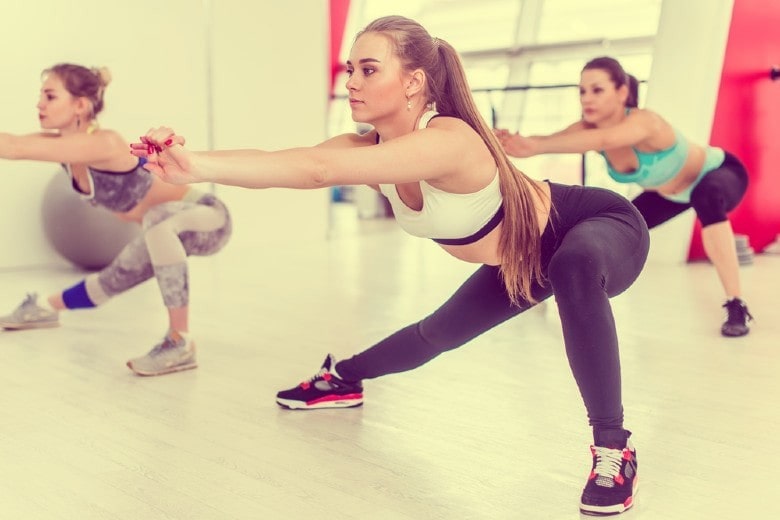Strong glutes are important for supporting your spine and posture while also improving your overall appearance.
However, unfortunately, when training the gluteal muscles, there are some mistakes you may be making that are preventing you from experiencing optimum results, which the following list of common glute training mistakes will show you.
To compile the list, we simply looked at what experts, such as personal trainers, sports nutritionists, and more, shared in their experience working with clients trying to build a better butt.
One thing they all stress, to begin, is that though doing glute exercises looks fun and easy, doing them wrong does more than just hinder you from reaching your desired outcome.
It also causes your other muscles to compensate for the underworked glutes, which can lead to chronic muscle pain.
Hence, you should make it a point to perform the moves correctly to also avoid injury.
Now that we have a bit of background into the benefits of properly training your butt muscles, let’s go through some of the mistakes you may be making during your exercises that can be counteracting your efforts to get strong buttocks.
10 Common Glute Training Mistakes You’re Making
- You’re Not Using the Right Resistance
- You’re Not Connecting With Your Body
- You’re Not Doing Enough Variations
- You’re Leaving Out Hip Thrusts
- You’re Glutes are Not Activated
- You’re Not Engaging Your Core and Keeping Your Back Straight During Upright Moves
- You’re Not Keeping Your Hips Square During Floor Work
- You’re Overextending Your Knees When Doing Lunges
- You’re Not Consuming the Right Diet or Eating Enough Calories
- You’re Not Recovering Properly
You’re Not Using the Right Resistance
To build your muscles, they must be challenged by some form of resistance, such as
weight-bearing exercises, which causes them to rip, so they can repair and grow.
However, several experts state that, all too often, they find that their clients are not using enough resistance to grow their butt muscles, which is preventing them from seeing results.
Therefore, they advise, once you become accustomed to feeling the burn during your exercises, increase your number of reps or add more weight to continue to challenge your muscles to transform.
You should also avoid taking on too much resistance or using weights that are too heavy when glute training because it can prevent your lower body from completing a full range of motion, which can cause a breakdown in your form and strain the other muscles.
As a general rule, when challenging your glute muscles using weights, select an amount that will allow you to maintain the proper form throughout the set.
It is also important to keep the tension in the muscle at least 3 to 5 seconds during the resistance to give them time to shred, and you should also aim for at least 5-reps per set for maximum burn.
You’re Not Connecting With Your Body
To grow your muscles, experts state that you need to also be mindful of your body’s form throughout each phase of the exercise.
In other words, you need to be intentional in your moves from the lifting to the lowering and even the peak contraction.
They further add that you should also perform your moves at a slow pace of about 2 to 5 seconds to really connect with your body.
It also helps make the moves harder, so you can decrease the number of reps you perform.
You’re Not Doing Enough Variations
Your glutes consist of 3 major muscles, the gluteus maximus, the gluteus minimus, and the gluteus medius, which all play a role in the strength and definition of the butt.
Therefore, you must work all three muscles for overall improvement, which performing a variation of workouts designed for the butt can help you do.
Furthermore, she adds, your glutes need to already be strong to perform certain moves with proper form, such as deadlifts and squats, so you need to incorporate a series of basic movements for the lower body, including lunges, double-leg variations, single-leg variations, and step-ups to help strengthen the muscles needed to do more complex moves properly.
Working your butt muscles with varying degrees of intensity, as well as also varying your reps, sets, and tempo each training day, also helps ensure you are targeting every muscle in the area for best results.
However, it is okay to repeat the same exercises from week to week to make it easier to track your progress.
Meanwhile, other experts state that training frequency and consistency also play a role in muscle growth.
Therefore, it is also recommended that you train your glutes at least 3 to 5 days per week for maximum benefits.
You’re Leaving Out Hip Thrusts
Hip thrusts for improved buttocks are the only exercise that solely activates and works all the glute muscles.
To increase the challenge, she suggests adding barbells to your thrusts once you get the hang of it.

Your Glutes are Not Activated
The less you use your glute muscles, the weaker they become, which can make it hard to know if you are activating your glutes during exercise or not.
Activating, or contracting, your glutes during your moves engages the muscles, which causes the microscopic tears needed to help them strengthen and grow.
If your muscles are not activating, then they are not getting strong, and you are also putting your other muscles at risk of compensating, which can cause discomfort in other parts of the body.
Therefore, he suggests doing warm-up exercises, such as glute bridges, prior to your routine to practice activating your glutes, so you can relearn how it feels when they are working and can ensure they are firing during your moves.
You’re Not Keeping Your Core Engaged and Your Back Straight During Upright Moves
Another common issue that can prevent people from building their buttock muscles is failing to engage their core during their exercises, which helps maintain a neutral spine and stability, thus keeping all the tension in the glutes.
This is especially important when performing more upright moves, such as deadlifts, squats, and lunges, that can naturally cause your lower back to concave during the exercise unless you are fully aware of your stance.
She recommends, to help keep your back straight during single-leg squats and lunges, begin with your dominant leg first and press your foot firmly into the floor, and when doing deadlifts, press both feet firmly into the ground.
It is also important to keep your back straight and your core engaged during floor exercises, such as donkey kicks, which can also put undue pressure on the lumbar spine and cause pain if not done properly.
You’re Not Keeping Your Hips Square During Floor Work
The fire hydrant is another effective move that helps strengthen and tone the glutes; however, to get the most from the exercise, it is important to keep the hips square while raising the leg.
Experts warn, otherwise, letting your hips rotate from side to side while performing the move only enables you to go through the motions but not work the glutes.
When doing fire hydrants, it is also important to keep your shoulders sturdy to help maintain a flat back and keep the resistance in the lower body.
You’re Overextending Your Knees When Doing Lunges
Experts share that doing lunges activates all the muscles in your bottom half, including the quadriceps, calves, hamstrings, and glutes.
However, the key is to not to let the knee extend too far over the toes, which helps keep the work mainly in the glutes and not in the quads and knees.
They stress that you should also be sure to keep your toes and knees straight and not pointed inward or outward during the exercise for best results.
Once you have the proper stance, lunge one foot forward, keeping your weight in the heel, and then move your body straight up and down to perform the move.
You’re Not Consuming the Right Diet or Eating Enough Calories
In addition to regular glute exercise, you need to also eat a well-balanced diet containing a mixture of complex carbs and protein to help build a better rump.
She states that protein is especially important during any type of resistance training because it helps repair muscle.
However, many people, especially women, are not consuming enough of it in conjunction with their workouts, which is why they’re not benefiting much from their efforts.
In general, you should eat a well-balanced meal of complex carbs and protein at least 2 to 4 hours before your training, and then since what you eat post-workout is also important to restore glycogen levels and build muscle, you should also consume a dose of BCAAS, such as a protein shake, within an hour of finishing your workout.
Overall, you should aim to eat at least one gram of lean protein per kilogram of bodyweight each meal, which is the equivalence of about 20 grams of protein per meal, in the form of lean chicken, beef, fish, eggs, tofu, or Greek yogurt, etc.
It is also important to consume the right amount of carbs per meal while trying to build butt muscle because your body needs them to function properly, burn calories and fat, and help increase mass.
However, these carbs should come from whole foods, such as grains, nuts, seeds, beans, legumes, fruits, and vegetables, which provide your body with the vital minerals, vitamins, antioxidants, and fiber it needs to keep you healthy and feeling good.
On the other hand, processed carbs, such as white bread, white pasta, and breakfast cereals, etc., have been stripped of their nutrients, so they offer no benefits for your body and can also spike your insulin levels, which can cause you to overeat and gain unhealthy weight.
Your daily carb intake should equal approximately 1 to 2 grams per pound of body weight, which for a 130-pound person should equal about 130 to 260 grams per meal.
Lastly, it is also important to add healthy fats, such as omega-6 and omega-3, to your diet because they help regulate your hormones.
They also help your body break down the protein you consume into individual amino acids to be used by the cells for development and repair.
And all it takes is about 0.4 grams of fat per pound of body weight per meal to reap the benefits.
In total, your calorie intake for the day should be about 16 calories per pound of bodyweight, which is about 2100 calories per day for a 130-pound person.

You’re Not Recovering Properly
Various experts state that contrary to popular belief that the more you exercise, the better, constantly training the same body parts each day can actually cause your muscles to break down instead of grow.
Therefore, they suggest working your glutes just 3-days a week and taking a rest day in between so your muscles have sufficient time to recover and repair, and you can continue training at your peak.
They stress that adequate sleep is also important for muscle recovery, so aim for 7 to 9 hours of sleep each night to enable muscle protein synthesis and the release of growth hormones, which are necessary to build, repair, and maintain healthy tissue.
Top Glute Training Devices
Looking to take your glute training to the next level? Try out these glute training workout equipment for an extra challenge.
| Booty Kicker | COBA Glute Trainer | Sunny Health & Fitness Squat Assist Row-N-Ride |
 |
 |
 |
| Why get the Booty Kicker? This glute trainer is perfect for those who like to do Barre exercises that shape their butt. | The COBA Glute Trainer is our top pick because of its ability to activate your glutes safer and more effectively than other squat exercises without this device. | The Sunny Health & Fitness Squat Assist Row-N-Ride is a must-have for those with a focus on compound exercises as part of their training program. |
 |
 |
 |
Final Thoughts
Now that you know the mistakes that could be getting in the way of achieving your perfect bottom, you can approach your workouts more mindful and in control of your results for a more exciting time, knowing you are making progress.
And you are not alone because I can’t wait to do it right along with you!



